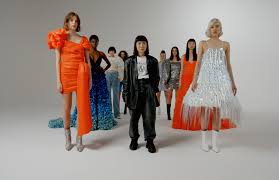
Fashion has always been a dynamic industry, constantly evolving and adapting to societal changes. In recent years, however, there has been a growing trend towards embracing technology and innovation in the fashion world. From smart fabrics to virtual reality runways, it seems that the future of fashion lies in the intersection of fashion and technology. But is fashion really the future of fashion? In this article, we will explore the various ways in which technology is transforming the fashion industry and discuss whether it is indeed the future.
The Rise of Wearable Technology
One of the most significant developments in the fashion industry in recent years has been the rise of wearable technology. From fitness trackers to smartwatches, these devices have become increasingly popular among consumers. Not only do they serve a practical purpose, but they also add a touch of style to one’s outfit. With advancements in technology, we can expect to see even more innovative and fashionable wearable devices in the future.
One example of wearable technology that has gained traction in the fashion world is smart clothing. These garments are embedded with sensors and other electronic components that can monitor various aspects of the wearer’s health or provide additional functionality. For instance, there are jackets that can charge your phone or shoes that can track your steps. As technology continues to advance, we can anticipate a wider range of smart clothing options that seamlessly blend fashion and functionality.
The Influence of Artificial Intelligence
Artificial intelligence (AI) is another area where technology is making its mark on the fashion industry. AI algorithms can analyze vast amounts of data to identify trends and predict consumer preferences. This information can then be used by designers and retailers to create personalized experiences for their customers. For example, AI-powered chatbots can assist shoppers in finding the perfect outfit or suggest complementary items based on their style preferences.
Moreover, AI is also being used in the design process itself. Fashion designers can now leverage AI tools to generate new designs, experiment with different patterns and colors, and even create virtual models to showcase their creations. This not only speeds up the design process but also opens up new possibilities for creativity and innovation in the fashion industry.
The Virtual Revolution
Virtual reality (VR) and augmented reality (AR) technologies are revolutionizing the way we experience fashion. Virtual reality allows consumers to immerse themselves in virtual fashion shows or try on clothes in a virtual fitting room. This technology provides a unique and interactive shopping experience, eliminating the need for physical stores and changing rooms. Augmented reality, on the other hand, enables consumers to overlay virtual clothing items onto their real-world environment, allowing them to see how an outfit would look before making a purchase.
These technologies not only enhance the shopping experience but also offer new opportunities for fashion brands to showcase their collections. Virtual fashion shows, for instance, can reach a global audience without the limitations of physical space and time. This opens up doors for emerging designers who may not have the resources to organize traditional runway shows. Additionally, virtual reality and augmented reality can also be used to create immersive storytelling experiences, bringing fashion campaigns to life in a whole new way.
The Sustainability Factor
In recent years, there has been a growing concern about the environmental impact of the fashion industry. From excessive waste to harmful manufacturing processes, the industry has faced criticism for its contribution to climate change and pollution. However, technology is offering solutions to these sustainability challenges.
One area where technology is making a difference is in the development of sustainable materials. Innovations such as biofabrication and 3D printing are enabling designers to create garments using eco-friendly materials that are biodegradable or made from recycled sources. Furthermore, technology is also facilitating transparency in the supply chain, allowing consumers to trace the origins of their clothing and ensure ethical production practices.
Conclusion
While it is clear that technology is transforming the fashion industry in numerous ways, whether it is the future of fashion remains to be seen. Fashion will always be driven by creativity, individuality, and personal expression. However, technology has the power to enhance and revolutionize these aspects, making fashion more accessible, sustainable, and innovative. As we continue to embrace the possibilities that technology offers, it is important to strike a balance between tradition and innovation, ensuring that fashion remains a reflection of our ever-evolving society.

